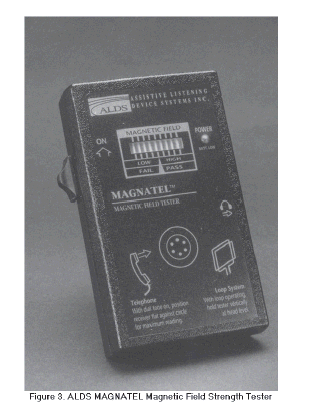2.1.2 Standards
There are no national US standards that define the required performance of IL systems. The International Electrotechnical Commission (IEC) has developed pertinent standards for "Magnetic field strength in audio-frequency induction loops for hearing aid purposes" (IEC, 118‒4, l981). Suggested modifications to these standards have been made by Oval Window Audio, a manufacturer of audio loops in this country. Standards developed at the National Technical Institute for the Deaf (Johnstone l997) are part of the NTS Uniform Fire Prevention and Building Code, Chapter 23 of the Laws of l989 (Title 9, Subtitle S, Volume 9 Executive [B] of the "Official Compilation of the Codes, Rules and Regulations of the State of New York"). Each of these wil l be briefly reviewed. In ensuring that the prescribed magnetic field goals are achieved, the utilization of a "magnetic field-strength" meter is assumed (see figure 3).

2.1.2.1 Summary of IEC 118‒4 (1981) Standards
With a source of 1000 Hz equal to the long-time average level of the speech signal applied to the input of the system, the resulting field strength within the loop shall average 100 mA/meter +/- 3 dB. This level should not go below 70 mA/meter or above 140 mA/meter. These values apply to the vertical component of the field strength inside the area enclosed by the loop, measured 1.2 meters above the floor. Allowing for the 12 dB peaks occurring in speech signals, peak field strength may reach 400 mA/meter. The frequency response shall be 100 Hz - 5 kHz +/- 3 dB. The document includes a statement that in schools for hearing-impaired children it may be desirable to boost the low frequencies to compensate for the decrement in the low frequency response often produced by the inductive process. The degree of such a boost, and whether and under what circumstances it should take place, is therefore a local option.
2.1.2.2 Additional Proposed Specifications (by Oval Window Audio)
1. Loop Wire Installation: In order to maximize signal strength and uniformity, the loop wire shall be installed either at floor or ceiling level. At least 80% of the installed loop should be free of the influences of metal, either in front of, or immediately behind the wire.
2. Field Strength: As per IEC 118‒4, with the additional condition that the measurements be "A" weighted to disallow the influence of inaudible low frequency power line electrical noise.
3. Input Signal Compression: To compensate for fluctuating signal input levels, an automatic gain control, signal compression, and/or adjustable non-distorting peak limited must be employed at the input of the system (Recommended compression ratios: 4:1 for music, and up to 20:1 for speech).
4. Frequency Response: Frequency response measurements conducted with an "A" weighted field strength meter must be corrected to compensate for the substantial low frequency roll off characteristic of this weighting network.
5. Ambient Electrical Interference: Sources of electromagnetic radiation that may interfere with the proper functioning of an induction loop system include: faulty fluorescent lighting, light dimmers, electrical wiring, TV and computer monitors, surge protectors that are in close proximity to the loop system. An on-site evaluation of ambient electromagnetic noise should be performed before a loop is installed in order to identify and resolve electromagnetic interference. Ambient electromagnetic noise should not exceed 25 mA/meter or –12dB ("A" weighting) re: 100 mA/meter as measured at any seat within the looped area. If potential sources of noise cannot be reduced or eliminated, then the use of a loop must be ruled out.
6. Signal Spillover: When adjacent areas are equipped with an induction loop, signal spillover must not exceed 12.5 mA/meter, or –18 dB ("A" weighted) re: 100 mA/meter as measured at any location within an adjacent loop. Listening tests should also be performed to determine if signal spillover is audible.
7. System Signal-to-Noise: The electrical signal to noise ratio of the loop amplifier output (measured directly, not inductively) at 1000 HZ must be at least +30 dB at an output level sufficient to deliver mA/meter as per IEC 118‒4 specifications.
8. Distortion: With an input signal of 1000 Hz and the system adjusted for an output of 100 mA/meter, harmonic distortion must not exceed 3%.
2.1.2.3 New York State Standards
Ambient electro-magnetic fields should not exceed 30 mA/meter; higher levels would preclude the installation of an IL in the particular location. In the event that adjacent areas were to be looped, magnetic field "spill-over" should not exceed 15 mA/meter. Given a 1000 Hz signal at a level equal to the long-time average level of speech, the average value of the magnetic field should be 100 mA/meter +/- 3 dB between 100 to 8000 Hz, with a maximum no greater than 400 mA/meter. This same signal should produce no more than 5% harmonic distortion and provide a signal to noise (ambient magnetic field) of at least 30 dB.

User Comments/Questions
Add Comment/Question